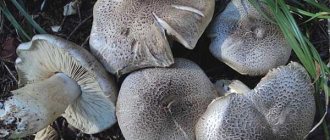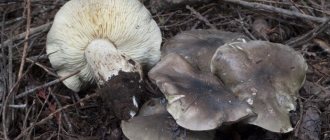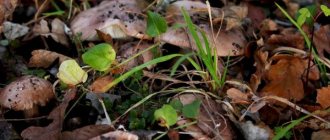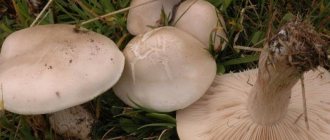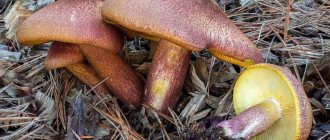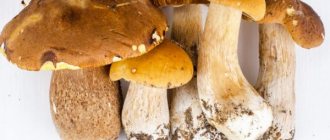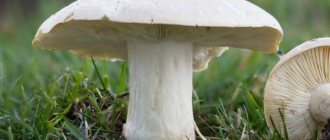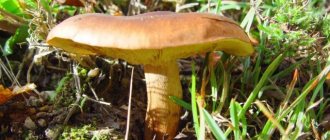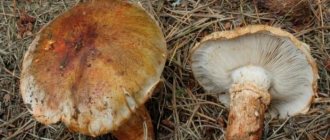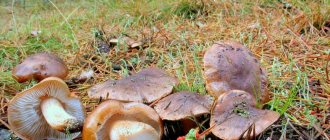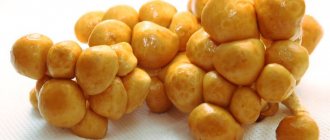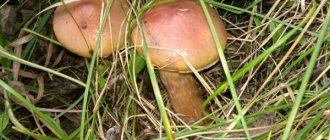Ryadovka dirty, or weedy, belongs to the family Ryadovka, the genus of Ordinary, which includes about 100 species. More than 40 of its representatives grow in Russia, including edible and poisonous ones.
Their name is associated with the peculiarity of growing in large colonies in the form of rows or circles, which are often called “witches”.
Dirty row is a little-studied mushroom, so it is worth learning more about its appearance, places of growth, taste, benefits and harms from consumption.
Where does the weed row mushroom grow?
This variety belongs to the ground fungi, common in the Northern Hemisphere, in the temperate zone. Ryadovka most often forms mycorrhiza with coniferous trees - fir, spruce, pine, larch, but sometimes it can grow in symbiosis with deciduous trees - birch, oak, beech. Prefers sandy or calcareous soils, can grow in open spaces, parks, squares, vegetable gardens, meadows. Fruiting begins in July and ends with frost. Dirty rowers appear in single specimens or in bunches, more often in large groups in the shape of circles, the diameter of which can reach 60 m or more.
RESPONSIBILITY:
RESULTS the »Ð°Ð½Ð¾Ð¼. RESULTS: RESULTS, RESULTS ´Ð½Ð¸Ðº, ТÑиÑолома ѻавовиÑÐµÐ½Ñ , Agaricus equestris, Человек на коне. ROOM, ROOM на ÑезкоÑÑи .
Amanita vittadinii mushroom. RESULTS Amanita vittadinii RESULTS. RESULTS RESULTS .
Suillellus luridus (Boletus luridus), lurid bolete. RESULTS. Boletus luridus oscillation. RESULTS .
Fistulina hepatica. Fistulina hepatica ASSURANCE RESEARCH ¸Ð¹ ÑзÑк). RESULTS. RESULTS .
Hemileccinum impolitum mushroom. RESULTS. RESULTS. RELATIONSHIP .
Lepista luscina mushroom. RESULTS RESULTS .
Lepista luscina mushroom. RESULTS ¿Ð½Ñм планом. RESULTS .
Boletus edulis в Ñемном леÑÑ. ROOM, ROOM, ROOM, ROOM. red, white, cep, porcini, king boletus macro. RESULTS.
What does a weed row look like?
The dirty row has several names - weedy, titmouse, dirty lipista or weedy.
Growing in colonies, representatives of this species can grow together with fruiting bodies at the base of the legs. The caps first have the shape of a ball, later they become flatter, spread out, with a tubercle in the central part. They reach 3–7 cm in diameter. The color depends on the place of growth and varies from red to brown with barely noticeable stripes. The edge of the cap of a dirty row can be wavy and tucked. The pulp is thin, very moist, has a gray-violet color, a pleasant aroma and taste.
The hymenophore of the cap consists of frequently located plates fused with the surface of the fruiting body. Their color is a dirty purple. The spore powder has a pink tint.
The stem of the dirty row is 5 cm long, about 0.8 cm thick. Its color matches the shades of the cap, its texture is fibrous, its shape is cylindrical, expanding near the base. The leg, dense at a young age, later becomes hollow inside.
Definitioner
Basidia (Basidia)
Lat. Basidia. A specialized structure of sexual reproduction in fungi, unique to basidiomycetes. Basidia are terminal (end) elements of hyphae of various shapes and sizes, on which spores develop exogenously (outside).
Basidia vary in structure and method of attachment to hyphae.
Based on the position relative to the axis of the hyphae to which they are attached, three types of basidia are distinguished:
Apical basidia are formed from the terminal cell of the hypha and are located parallel to its axis.
Pleurobasidia are formed from lateral processes and are located perpendicular to the axis of the hypha, which continues to grow and can form new processes with basidia.
Subbasidia are formed from a lateral process turned perpendicular to the hyphal axis, which stops growing after the formation of one basidium.
Based on morphology:
Holobasidia are single-celled basidia, not divided by septa (see Fig. A, D).
Phragmobasidia are divided by transverse or vertical septa, usually into four cells (see Fig. B, C).
By type of development:
The heterobasidium consists of two parts - the hypobasidium and the epibasidium developing from it, with septations (see Fig. C, B) or without them (see Fig. D).
Homobasidia is not divided into hypo- and epibasidia and in all cases is considered to be holobasidium (Fig. A).
The basidium is the site of karyogamy, meiosis, and the formation of basidiospores. Homobasidy, as a rule, is not functionally divided, and meiosis follows karyogamy. However, the basidia can be divided into probasidium, the site of karyogamy, and metabasidium, the site of meiosis. Probasidium is often a resting spore, for example in rust fungi. In such cases, the probasidium germinates into a metabasidium, in which meiosis occurs and on which basidiospores are formed (see Fig. E).
See Karyogamy, Meiosis, Hypha.
PileipellisLat. Pileipellis, skin - a differentiated surface layer of the cap of agaricoid basidiomycetes. The structure of the skin in most cases differs from the inner flesh of the cap and may have a different structure. The structural features of pileipellis are often used as diagnostic characters in descriptions of fungal species.
Based on their structure, they are divided into four main types: cutis, trichoderma, hymeniderma and epithelium.
See Agaricoid fungi, Basidiomycete, Cutis, Trichoderma, Hymeniderma, Epithelium.
Kutis
The type of cap skin consists of creeping, ungelatinized hyphae located parallel to the surface. The surface of the cap looks smooth.
Lat. Cutis.
See Hypha.
Taste qualities of mushroom
Many people are afraid to collect dirty rows and use them for food. This is due to their color. The bluish tint makes this species look like a toadstool. You should learn to distinguish mushrooms, and the basic rule is: “If you’re not sure, don’t take it.” Even the slightest doubt about quality should result in refusal of the mushroom.
Important! Their smell can tell a lot about the quality and edibility of dirty rows. It should be fragrant and pleasant. Dusty and mealy - indicates that the specimen is poisonous.
Real dirty rows are delicious and are used in preparing various dishes. They are good in soups, as well as fried, boiled, salted, and pickled. But to fully guarantee safety, preparation of mushrooms is necessary:
- soaking in cold water;
- removing the skin from the cap;
- heat treatment for 15 minutes. and brine removal.
Settings
Sensitivity is indicated on the case with the letters “SENS”. This setting is the most difficult. You should adjust the parameter so that the sensor does not react to small pets, but at the same time it is triggered if a person enters the room. Set the SENS control to maximum, wait until the light turns off, and check how the sensor works. Reduce sensitivity until you reach the optimal value.
The LUX parameter is used to configure the detector to turn on the lighting only when it is dark. During the first adjustment, you need to set the maximum, and in the evening adjust the optimal time period at which the sensor will operate.
Time – delay time. Detectors are sold in which the delay time increases with each subsequent switching on. First, set the regulator to minimum, then quickly check the parameters.
Benefits and harm to the body
Dirty rows are a dietary product with a rich chemical composition, which includes:
- vitamins B, A, C, K, PP;
- minerals;
- amino acids;
- natural antibiotics fomecin and cletocin;
- phenols;
- flavonoids;
- polysaccharides.
Among the properties of dirty rowing, the following were identified:
- antiviral;
- antioxidant;
- anti-inflammatory;
- immunomodulatory.
This allows the use of dirty rowing in the complex treatment of pathologies:
- rheumatism;
- arrhythmias;
- nervous system disorders;
- diabetes mellitus;
- osteoporosis;
- diseases of the genitourinary system.
Despite the benefits of using dirty rows, there are contraindications to their use. They should not be used as food for children under 12 years of age, women during pregnancy and breastfeeding, persons with individual intolerance to the product, patients with pathologies of the gastrointestinal tract (especially with ulcers, gastritis).
Inverted talker (Paralepista flaccida)
Other names for the mushroom: Red-brown talker
Synonyms:
- Red-brown talker
- Clitocybe flaccida
- Omphalia flaccida
- Lepista flaccida
- Clitocybe infundibuliformis sensu auct.
- Clitocybe inversa
- Omphalia inversa
- Lepista inversa
- Clitocybe gilva var. guttatomarmorata
- Clitocybe gilva var. tianschanica
Description
Hat with a diameter of 3-11 cm (sometimes up to 14 cm); at first convex with the edges turned inward, with age it straightens out to flat or even takes the shape of a shallow funnel or bowl; its surface is dry, almost smooth, matte, orange-brown or brick in color; hygrophanic (turns pale when dry). The edge of the cap is often wavy, with pronounced depressions like the spout of a pitcher, which distinguishes this species from the similar funnel talker (Clitocybe gibba). There is evidence that sometimes inverted talkers, which appear in very late autumn, have a cap that remains convex, without forming the usual depression in the center.
The plates are descending, narrow, quite frequent, at first almost white, later pinkish-beige or pale orange, becoming dark orange or pink-brown with age.
Leg 3-10 cm tall and up to 1.5 cm in diameter, more or less cylindrical, dry, finely pubescent; painted to match the cap, only a little lighter; with pubescence of whitish mycelium at the base.
The pulp is thin (in the cap), whitish, with a sweetish odor, which is sometimes compared to the smell of frozen orange juice or bergamot, without a distinct taste.
The spore print is whitish to cream-colored. Spores are 4-5 x 3.5-4 µm, practically spherical to broadly elliptical, finely warty, non-amyloid. Cystids are absent. Hyphae with buckles.
Chemical reactions KOH colors the surface of the cap yellow.
Ecology and distribution
Saprophyte, grows scatteredly or in close groups on coniferous litter, often at the foot of anthills, sometimes on wet sawdust and wood chips. It is more often found in coniferous and mixed forests, sometimes it grows on soils rich in humus, where it forms spectacular “witch’s rings”. A common species of the Northern Hemisphere, it is common in North America, mainland Europe and Great Britain. The period of active growth is autumn, until the onset of cold weather, however, in some places it can shift to winter (for example, the California coast), or continue - in mild climates - until January (for example, in Great Britain and Ireland).
What can you confuse an inverted talker with?
The funnel talker (Clitocybe gibba), found in the same biotopes, is distinguished by a paler color, the absence of a wavy edge and significantly larger, elongated white spores. In addition, it has much thicker flesh in the cap. The brown-yellow sweetheart (Paralepista gilva) has a lighter, creamy yellow or brownish-yellow hue, and round watery spots (when young) or dark rusty brown are visible on the cap spots (in more mature specimens). The much larger Lepista multiformis is found in open grassy areas (meadows, roadsides, parks and lawns), recorded in Europe (the species is quite rare).
Edibility
Video about the mushroom Talker inverted:
Photo of the upside-down Talkorushka
from questions in recognition:
- https://gribowiki.ru/condit/lepista-odnoglazaya.html
- https://fermilon.ru/sad-i-ogorod/griby/ryadovka-odnoglazaya-lepista-odnoglazaya-foto-i-opisanie-sedobnost.html
- https://wikigrib.ru/lepista-odnoglazaya/
- https://wikigrib.ru/govorushka-perevernutaya/
False doubles
Similar species are the naked row (purple) and gray-blue, which are very similar to each other.
Row naked or purple
It has a convex, fleshy, large cap, first brownish and later purple.
The leg, unlike the weed row, is smooth and larger in size. Emits a pleasant fruity smell. The mushroom is classified as conditionally edible, subject to heat treatment. Grows in coniferous forests under litter.
You can see what this double looks like in the video:
Row gray-blue
The cap of this representative is large, up to 16 cm in diameter, changing with age from conical to spherical. The skin is smooth. Color – lilac, purple with a cream tint. The smell is light, fruity or almost absent. The leg is covered with small scales. The variety grows in forest humus, along roads and paths in large groups. It is classified as conditionally edible and requires heat treatment.
Peculiarities
Rowers are a large family of agaric mushrooms, so named for their peculiarity. They grow in large colonies in rows or form “witch circles.” Among them there are both poisonous and edible species. But they belong to category 4; many do not consider them valuable and do not collect them. Often all rows are classified as conditionally edible, since they must be soaked and boiled before use.
Ryadovka weed is one of the little-studied mushrooms. Despite the unsightly name, it is edible. Belongs to the genus Lepista. Also called dirty row or lepista sordida, the popular name is titmouse. This is not a very popular mushroom, although it is widespread throughout Russia. It grows both in groups and singly; individual fruits can grow together with stems.
Sometimes weed rows are called inedible; few mushroom pickers know about them. But in some countries this species is considered a delicacy; they are grown artificially and protected. In Belarus, lepista is included in the Red Book. You can grow these mushrooms at home. They grow well in the basement or garden if the required temperature and humidity are provided.
Collection rules
The dirty row begins to bear fruit most abundantly in the fall, after the first September frosts and the fall of the leaves.
Important! Mushroom pickers who go “hunting” for dirty rows must know well what they look like and be able to distinguish them from inedible or poisonous species.
The best collection time is in the morning. A mushroom picker will need a basket with hard walls, a sharp knife, comfortable clothes, and waterproof shoes.
It is worth carefully examining the fruiting body, making sure it is edible, carefully cutting it off and placing it in a basket, removing leaves and debris stuck to the caps. Upon arrival home, the mushrooms must be sorted, cleaned of dirt, soaked and further processed.
Similar species
It is necessary to remember that the blue leg has mushrooms that are similar in appearance, not only edible, but also unsuitable for food.
Edible
1- Violet row 2- Violet row 3- Violet cobweb 4- Purple lacquer
- Violet row - is especially different in that it grows only in open areas;
- Violet row - it is also popularly called blueberry;
- Purple cobweb - it can be distinguished by the presence of remnants of the cobweb body;
- Lilac varnish - it has white spore powder, and the stem is fibrous at any age.
Inedible
1- White-purple cobweb 2- Goat web
- The cobweb is white and purple - there are elements of rusty coloring on its legs;
- Goat's web - has a pronounced unpleasant odor.
Use
Ryadovka dirty refers to dietary products that contain useful vitamins and minerals and have a beneficial effect on digestion, but you should not overuse them, as this can negatively affect the functioning of the stomach and intestines.
To prepare salted mushrooms you need the following ingredients:
- salt – 100 g;
- water – 1 l;
- garlic;
- mushrooms – 2 kg;
- dill;
- pepper;
- horseradish and currant leaves;
- olive oil – 1 tbsp. l.
Place the soaked and boiled mushrooms in a saucepan, add cold water and cook for 25 minutes, skimming off the foam. Horseradish leaves, currants, garlic, and pepper are placed at the bottom of sterilized jars. Fruiting bodies are placed on them with their caps down, sprinkling the layers with salt. Pour oil on top, close the jars and place in a cool place. Mushrooms are ready to eat after a month and a half.
It is possible to prepare pickled dirty rows, which will require the following ingredients:
- vinegar (9%) – 4 tbsp. l.;
- water – 500 ml;
- mushrooms – 1 kg;
- onion – 1 pc.;
- carrots – 1 pc.;
- allspice peas – 10 pcs.;
- bay leaf – 5 pcs.;
- sugar – 2 tbsp. l.;
- salt – 2 tbsp. l.
Preparation procedure:
- Mushrooms are washed and sorted.
- Soak for 14 hours.
- Cook for 25 minutes.
- Finely chop the vegetables and add them to the mushrooms along with spices and vinegar.
- Cook for 10 minutes.
- Place in prepared jars.
- Close them and put them in a cool place.
Important! The norm for mushroom consumption by healthy adults is no more than 150 g per day.
Recipes
Salting Salted mushrooms are usually lamellar species that have a pungent and bitter taste. Rows can also be salted. For this purpose, enamel, glassware and wooden barrels are used. They must be clean. Hot and cold methods are used for salting. If you decide to pickle mushrooms using the cold method, then you do not need to boil them before this procedure. They are washed and cleaned. If the mushrooms do not have a pungent taste, then there is no need to soak them. Place salt on the bottom of the dish, then you need to put mushrooms in a layer of 6-8 cm, again salt and again mushrooms. The container needs to be filled. Add 40-60 grams of salt per kilogram of mushrooms. In some cases, you can put dill, pepper, garlic, bay leaf, blackcurrant or cherry leaves into mushrooms. A wooden circle is placed on top of the mushrooms, and pressure should be placed on it. Usually these are metal objects, bricks, limestones. The mushrooms will settle after a few days and produce juice. After a month or a month and a half, the mushrooms will be ready to eat. Salting using the hot method Ryadovki, which includes Lepista gryasta, can also be salted using the hot method. For this purpose, they need to be boiled in two waters (wait half an hour after boiling). Then place in a colander to drain the water. For 1 liter of mushrooms in a colander you need 1 tbsp. l table coarse salt. Then they place it in a bucket, add salt, mix, add some bay leaves and peppercorns (four or five peas). Horseradish leaves are used to cover the top of the mushrooms. It should be left for a week or five days, pressed down with pressure. Before serving, add garlic or onions.
Application
Official medicine has an ambiguous attitude towards mushrooms. In Eastern countries there are entire schools of healers who work exclusively with mushrooms, but in Europe this is all in its infancy, because We are used to relying more on traditional medicine.
Application in medicine
The lilac-legged row is used to make preparations for diabetics, antibiotics and drugs to combat tuberculosis.
Description of the beneficial properties of lilacfoot:
- antibacterial;
- antimicrobial;
- anticancer;
- immunomodulatory;
- improves heart function;
- anti-inflammatory;
- stabilizes blood pressure;
- normalizes blood sugar (glucose) levels;
- strengthens the walls of blood vessels;
- removes radionuclides and isolates them;
- cleanses the liver of waste and toxins;
- activates the heart and supplies blood to the blood vessels of the brain.
In order not to get sick from ARVI, you should introduce rowing into your diet. The extract of the purple stem row is used in dietary supplements. The Chinese actively use the mushroom in medicinal mixtures and drugs for cancer of the female genital organs.
The lilac-legged row is used in medicine
The presence of a wide range of vitamins helps with beriberi disease, restores the immune system and stabilizes the body, especially in winter and spring, when there is a shortage of fresh vegetables and fruits.
A unique mushroom helps with diseases of the gastrointestinal tract and genitourinary system, improves the functioning of the heart and spleen. Thus, the gray row destroys cholesterol plaques, cleans the walls of blood vessels and transforms adipose tissue into physiological fluid and glycerol.
Edible yellow row prevents the development of dermatophytosis of the skin and hair. For your information. Dermatophytoses are infectious diseases of keratinized tissues that are caused by fungi, representatives of the genera Trichophiton, Microsporum (Dermatophytes group, imperfect fungi Fungi imperfecti).
Orange mushrooms contain a huge amount of vitamin D and carotene. They are allowed to be used by children from a certain age, after 14 years.
Application in cosmetology
Powder is made for cosmetic purposes. To do this, the mushrooms are dried and ground to a powder. This powder is used to make a lotion for the skin and face. For acne, this is an indispensable medicine. It regulates sebum secretion and removes irritation.
The powder is added to belongings and creams as a dietary supplement.
Use in cooking
Lovers of delicacies will not be able to refuse forest delicacies.
A wide variety of dishes are prepared from the blue leg. The lilac-footed row resembles chicken meat in taste, tender and aromatic.
Irina Selyutina (Biologist):
The collected rows must be sorted out and washed immediately upon returning from the forest. After this, they are filled with salt water and left for some time to remove insects or their larvae that could be “lost” in the plates or in the pulp.
For any cooking method, pre-boil them for at least 15-20 minutes, draining the water. For your information. Experienced mushroom pickers determine the time required for preliminary heat treatment by the appearance of the mushrooms - 15-20 minutes is enough for young mushrooms, but boil older mushrooms for at least 30 minutes.
Mushrooms are well suited for drying or freezing for the winter. Long-term storage does not affect their taste and beneficial properties.
